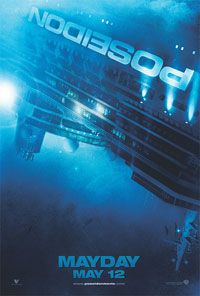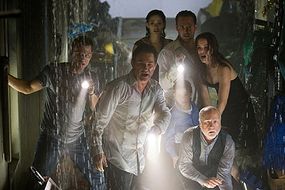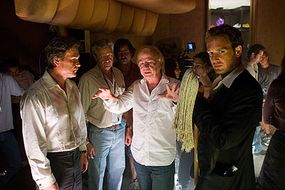Thirty-four years after disaster film producer Irwin Allen inverted a cruise ship in the name of entertainment, Wolfgang Petersen -- who knows a bit about boat-themed cinema -- has upended another Poseidon and drowned thousands with $160 million worth of watery effects.
Petersen, the director of "Das Boot" and "The Perfect Storm," aimed to close out his nautical trilogy "using all the tools we have to make it truly frightening and really realistic and really get across the idea what disaster is. That's what I wanted: realistic, very hard-edged, scary like hell." His version, based on Mark Protosevich's screenplay, keeps the original concept but scraps just about everything else from Paul Gallico's novel and the 1972 film, including the characters. "Neither would work today," he explains.
Advertisement
The assemblage of would-be escapees now includes Josh Lucas as a professional gambler, Kurt Russell as the ex-Mayor of New York traveling with his daughter (Emmy Rossum) and her fiancé (Mike Vogel), Richard Dreyfuss as a despondent architect, Jacinda Barrett as a single mom and Mia Maestro as a stowaway.
Why sign on for a film where the actors take a back seat to the effects and you're guaranteed to be wet most of the time? For Dreyfuss, it was the hefty paycheck. For Lucas, it was the physicality of the role. And for Russell, it was the chance to work with Petersen and perform a key underwater sequence that we won't spoil here.
Vogel liked the idea of being in a huge disaster flick. "We're drawn to catastrophe for some reason and we want to experience that without having to really experience it. I think that's why films like this and 'The Day After Tomorrow' are wildly popular," he muses. "You realize how little a part you actually play. The star of this movie is that boat, that water, and that's what Wolfgang does best."

Those elements came to life with the help of more than 600 visual effects, starting with the computer-generated ocean and ship exterior that opens the film. Lucas' solitary jog was filmed against a green screen at the Sepulveda Dam in Los Angeles and integrated with CGI created by the team of visual effects supervisor Boyd Shermis.
The Poseidon's interior took massive shape on five soundstages at the Warner Bros. Studio lot in Burbank, California, where Stage 16 housed a 95-by-100-by-22 foot tank with a capacity of 1.3 million gallons, enlarged since Petersen made "The Perfect Storm" there.
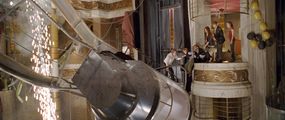
The crew built most sets in both right-side-up and upside-down versions, the latter requiring unique specifications. It took 100 crewmembers five months to build the 72-foot high inverted ship lobby, using 750,000 pounds of I-beam steel, 10,000 sheets of plywood, and rust-resistant auto body paint. The crew built most of the sets atop hydraulic gimbals that tilted side to side, fore and aft, and could pitch and yaw. The ship's bridge was too large to rotate in one piece without scraping the soundstage's ceiling so it was built and shot in two sections.
"The first time we walked onto the upside down lobby set, everyone started laughing because they'd never seen anything that elaborate," remembers Vogel. "Then Wolfgang put on 'Thus Spake Zarathustra' and started directing to this loud music. It was all surreal."
The inverted surroundings were disorienting at first, says Rossum. "You do get used to having the lights on the floor, although they're really hot and sometimes would burn through our shoes."
Fire came into play in several sequences, including one featuring Lucas diving under water aflame with burning oil. John Frazier's special effects team treated flat pieces of metal with propane and suspended them two inches above the water's surface to achieve the fiery effect as seen from below.
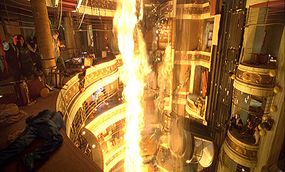
Other scenes required massive quantities of water. Ten 8-foot-diameter culvert pipes served as the conduit for the 90,000 gallons of water used to submerge the ship's ballroom. Cameramen in wet suits and goggles operated five cameras set at different speeds -- and sealed in watertight housings -- captured the action.
The actors also spent a lot of time submerged in water. Jacinda Barrett described a grueling 10-day shoot involving Lucas and her trapped son: "To make us sink a bit in the water they would put weight belts on us. They put an added weight belt on me because I wasn't getting low enough and they put extra on Jimmy and I didn't know they did that. I kept going lower and lower and I had this kid in my arms, and my eardrums felt like they would burst. The water safety people rushed in, but it was really scary. Your normal senses of judging things are out the window once you're underwater. You can't see anything. I was always worried that if I was really panicked they'd just think I was doing a good job acting!"
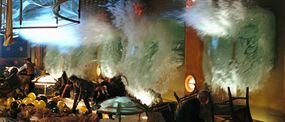
The actors also had to contend with air hoses blowing in their faces under water to get their hair out of the way. "And because there was so much bubbling, they had to tie all the debris with fishing wire so it would stay in place," says Barrett, noting that Petersen "wanted us to do as much of the stunts as we could. The only moments where I saw it wasn't me and was a CGI person, was in the ballast tanks -- I could see CGI bodies in the waterfall."
Next, we'll take a look at how the "Poseidon" actors trained for their roles and the difficulties of working underwater.
Advertisement
